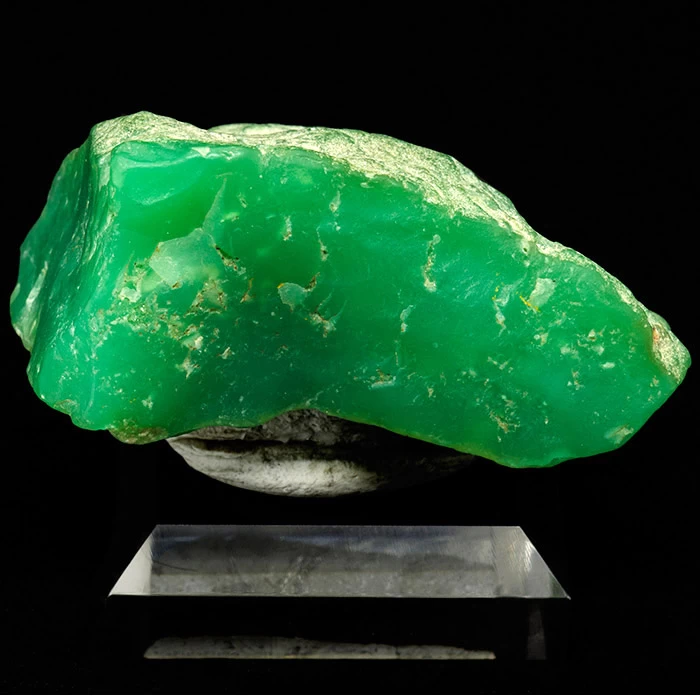Chrysoprase: Meaning, Properties, Facts and Photos

What is Chrysoprase?
Chrysoprase is a type of green chalcedony coloured by nickel impurities, but not all green chalcedony is chrysoprase.
Chalcedony is a cryptocrystalline variety of quartz, meaning its crystals are too small to be seen with the naked eye.
For a mineral to be called chrysoprase, its colour must be caused by nickel; if caused by other impurities, it's simply green chalcedony.
Although best known for its apple-green colour, chrysoprase can also be found in several shades of green. Stones can be translucent to opaque.
Like most varieties of quartz, chrysoprase is relatively hard. On the Mohs scale of hardness, it grades 6.5 to 7.
Chrysoprase is widely used as a gemstone and for ornaments and other decorative items. The finest material is void of flaws, fractures and inclusions.
Although sometimes mistaken for emerald, the colour of chrysoprase comes from nickel, whereas the colour of emerald comes from chromium.
Some of the finest gem-grade chrysoprase comes from Queensland, Western Australia, Germany, Poland, Russia, Arizona, California and Brazil.
Chrysoprase History and Meaning
The mineral chrysoprase has been known for at least seven thousand years. Artefacts, including items of jewellery from an ancient settlement in the Indus Valley (now Pakistan), were found to contain this green variety of quartz. However, the source of the stone has not been established.
Chrysoprase found in archaeological sites in India dates back to 5,500 to 2,600 BC.
Chrysoprase is known to have been used in ancient Egypt but wasn't that common. It was imported to make scarabs, particularly 'heart scarabs.' These symbolised rebirth after death, so were placed close to the heart of the deceased beneath the bandages used to wrap the mummy.
Ancient Roman author and naturalist Pliny the Elder wrote about chrysoprase (chrysoprasus) in his encyclopedia, Naturalis Historia. There's some confusion about what exactly was written. One author claims Pliny associated chrysoprase with 'prason,' which means 'leek,' while another says he described it as "having the colour of leek juice with a golden tinge."
The meaning of chrysoprase comes from its colour, which is said to be a mixture of yellow and green. The name comes from the Greek words 'khrysos,' meaning 'gold' and either 'prasinos,' meaning 'greenish,' or 'prason,' meaning leek.
Either way, the combination of the two words reflects the stone's characteristic yellow-green, apple-green or leek-green colour.
The chemical composition of chrysoprase was not fully understood until the 18th century. It began being mined commercially around 1740.
Chrysoprase jewellery was particularly popular during the Victorian era. Designer Peter Fabergé often worked with the finest grade stones.
During the Middle Ages, gem-grade chrysoprase was used lavishly in Europe. It was mined in the Northern Czech Republic and Southern Poland. Once these deposits were exhausted it became far more expensive.
Many buildings in Prague are decorated with chrysoprase, the most famous being the Chapel of St. Wenceslas.
(Reference Sachanbiński, Michał, Kuleba, Mirosław and Natkaniec-Nowak, Lucyna. "Chrysoprase – history and present" Mineralogia, vol.54, no.1, 2023, pp.1-10.)

Article Pictures
The chrysoprase in the photo at the top of our page is courtesy of Steve Blyskal. The piece in the second photo is housed in the Smithsonian Natural History Museum, Washington D.C., Photo by Stone Mania.
Images are clickable and redirect to the original photo.
Pop-up photo: Emerald - Courtesy of Géry Parent.







